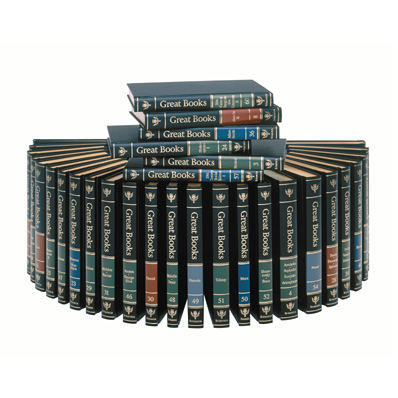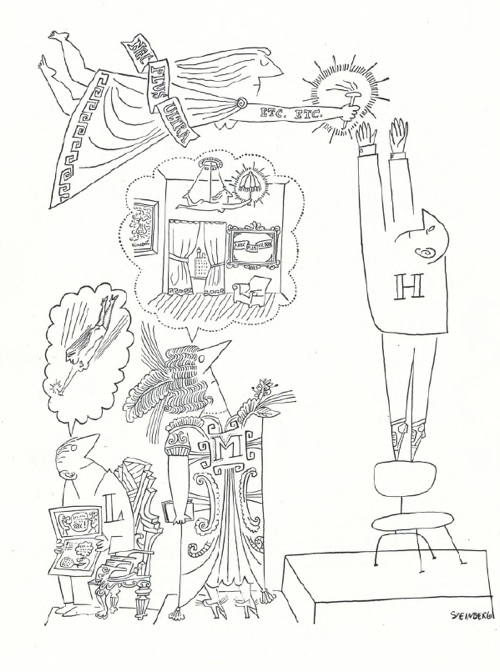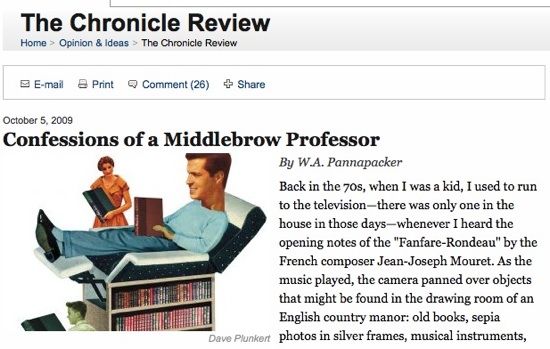Middlebrow Disinfo
By:
October 19, 2009
Every now and then, a well-meaning intellectual mounts a three-quarters-hearted defense of Cold War-era High Middlebrow — i.e., the Great Books of the Western World collection, the Book-of-the-Month Club, Masterpiece Theatre, the arts magazine Horizon, the B.B.C.’s Home Service programs.

As previously noted, Russell Lynes mounted such a defense in 1949; his “Highbrow, Lowbrow, Middlebrow” described America as a caste system presided over by proto-authoritarian highbrows who’ve failed to keep the benighted lowbrows in their place only because of the courageous efforts of virtuous, value-creating “upper middlebrows.” Andrew Ross did it in 1989; his No Respect: Intellectuals and Popular Culture argued that postwar highbrows latched onto the term “middlebrow” as a “containing structure,” i.e., in order to protect their own cultural and intellectual authority.
Susan Jacoby did it just last year; in The Age of American Unreason, she recounts: “I look back on the middlebrow with affection, gratitude, and regret rather than condescension, not because the Book-of-the-Month Club brought works of genius into my life, but because the monthly pronouncements of its reviewers encouraged me to seek a wider world.” (Low Middlebrow also has its intellectual defenders: in his 2007 book Let’s Talk About Love: A Journey to the End of Taste, Carl Wilson makes a parallel case on behalf of schmaltz, kitsch, and Céline Dion.)
Why have Lynes, Ross, and other intellectuals forced themselves to appreciate (though not actually enjoy) Cold War-era High Middlebrow productions? For the noblest of reasons. Because they approve of the populist mission (equal educational opportunity, social mobility, self-improvement) that we’ve all been encouraged to believe was High Middlebrow’s; and because they disapprove of what we’ve all been encouraged to believe was/is the snobbishness of High Middlebrow’s critics. “Two cheers for Middlebrow!” the well-meaning intellectual, who appreciates High Middlebrow productions, though (again) she doesn’t enjoy them, bravely insists. The mandarins be damned!

It’s not so courageous, though, defending Middlebrow. Sure, the canon-protecting highbrows and above-it-all nobrows might mock you for doing so — but so what? They have neither power nor much influence, any longer. Middlebrow has a lock on the power (New York and Hollywood are middlebrow towns), and (thanks to Quatsch) on most of the influence, too.
Middlebrow has managed to persuade us that there are three dispositions: Highbrow vs. Lowbrow, with Middlebrow mediating. For example, reviewing the latest New York Film Festival early this month in The New York Times, middlebrow critic A.O. Scott laments that
What was once a wide and crowded middle ground between popular taste and high art has eroded…. Ideally and at its best, the kind of high-minded middlebrowism represented by the New York Film Festival could provide a bridge for curious patrons, a path from the familiar and the fun toward the rarefied and the difficult, as well as a yearly sampling of world cinema in all its protean abundance.
Also, Middlebrow has persuaded us that this tripartite model of the dispositions maps closely onto our class system: the upper class vs. the lower class, with the middle classes (upper and lower) mediating between them. The promise of social mobility, from lower to upper class, hinges on the existence of the middle classes; or so we’re led to believe.
Who or what has encouraged us to believe that High Middlebrow’s aim is to bridge the cultural gap between Lowbrow (identified with the lower classes) and Highbrow (identified with the upper), and in so doing somehow prevent our freedom-loving liberal capitalist social order from hardening into an undemocratic caste system? Middlebrow. Who or what has encouraged us to believe that anti-Middlebrow critics are assholes? Middlebrow. So these supposedly contrarian defenders of Cold War-era High Middlebrow merely parrot the dominant discourse’s propaganda; worse, they’re misreading — or disreading — High Middlebrow’s brilliant critics.

The most recent misfire comes from W.A. Pannapacker, who reviewed Alex Beam’s A Great Idea at the Time: The Rise, Fall, and Curious Afterlife of the Great Books in The Chronicle of Higher Education earlier this month. (Beam is a friend, but I’d recommend this book — though it falls into the Lynes/Ross/Jacoby category — even if he weren’t.) In “Confessions of a Middlebrow Professor,” Pannapacker stops short of comparing High Middlebrow’s critics to Hitler or Stalin — which was Lynes’ specialty. However, he does trot out the same old arguments in defense of High Middlebrow productions like Masterpiece Theatre, PBS documentaries on science and culture, the Time-Life Library of Art, and (yes) the Great Books.
“For all their shortcomings, the Great Books — along with many other varieties of middlebrow culture — reflected a time when the liberal arts commanded more respect,” writes Pannapacker. “They were thought to have practical value as a remedy for parochialism, bigotry, social isolation, fanaticism, and political and economic exploitation. The Great Books had a narrower conception of ‘greatness’ than we might like today, but their foundational ideals were radically egalitarian and proudly intellectual.”
Pannapacker approvingly quotes Beam:
“The animating idea behind publishing the Great Books, aside from making money for Britannica and the University of Chicago,” Beam observes, “was populism, not elitism.” The books were household gods. They shared the living room with the television, and they made you feel guilty for being intellectually passive, for not taking control of your own mental development, for putting democracy at risk. “And thousands of copies, perhaps tens of thousands, were actually read, and had an enormous impact on the lives of the men, women, and children who read them.”
He quotes Susan Jacoby:
The Great Books — along with all those Time-Life series — were often “purchased on the installment plan by parents who had never owned a book but were willing to sacrifice to provide their children with information about the world that had been absent from their own upbringing,” Jacoby writes. They represented an old American belief — now endangered — that “anyone willing to invest time and energy in self-education might better himself.”
And he references Lynes’ take-down of one of the earliest, most ferocious anti-middlebrows, Virginia Woolf:
As the Harper’s Magazine editor Russell Lynes argued in his 1949 essay “Highbrow, Lowbrow, Middlebrow,” the ideal world for Woolf is a caste system in which billions of bovine proles produce the raw materials for a coterie of sensitive, highbrow ectomorphs who spring fully formed from the head of Sir Leslie Stephen. At the very least, lowbrows with upward aspirations should have the courtesy to keep themselves out of sight until they complete their passage through the awkward age of the middlebrow.
Pannapacker would have us believe, in other words, that Middlebrow is the solution — the dialectical synthesis of Highbrow and Lowbrow, the happy ending to America’s struggle between aristocratic and democratic ideals. Cold War-era High Middlebrow was egalitarian/populist/democratic. It aided regular folks who wanted to educate and improve themselves, who aspired to greater things (intellectual or economic). High Middlebrow’s critics aren’t merely upper-class snobs and twits — they’re un-American! Pannapacker, who describes his own family as working or lower middle-class, has an axe to grind when it comes to elitist snobs who sneer at Middlebrow. He criticizes the upper-class types he met in college who “took the intellectual life for granted — who didn’t think reading was praiseworthy in itself — and who looked down on the striver’s culture from which I emerged as ‘middlebrow.'”
Critics of Middlebrow (Woolf and Dwight Macdonald are named) want to keep upwardly mobile strivers in their place, claims Pannapacker. If you believe in the tripartite model described above (Highbrow vs. Lowbrow, with Middlebrow mediating), and if you believe that this model maps neatly onto our class system, then it’s difficult — perhaps impossible — to disagree with Pannapacker. But this model is wrong, wrong, wrong!
